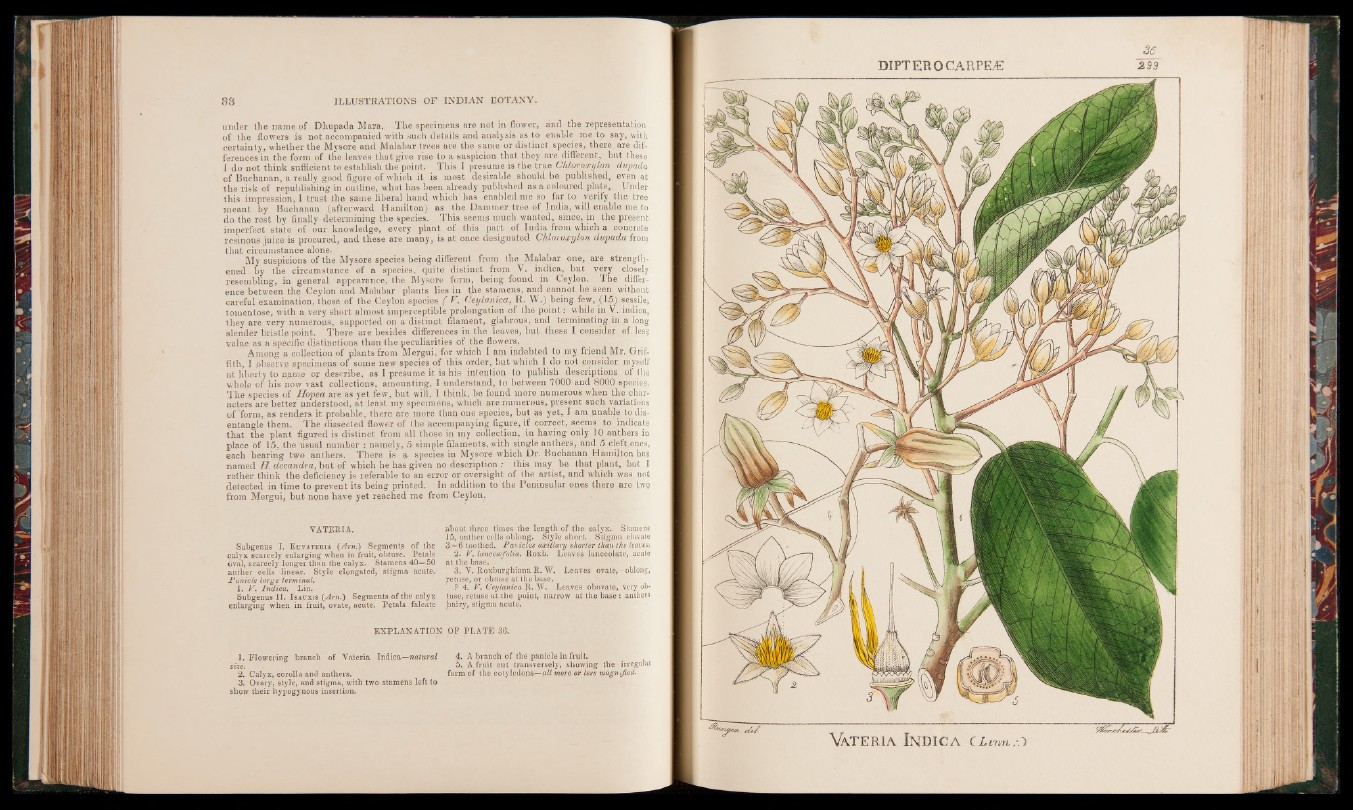
under the name of Dhupada Mara. The specimens are not in flower, and the representation
of the flowers is not accompanied with such details and analysis as to enable me to say, with
certainty, whether the Mysore and Malabar trees are the same or distinct species, there are dif-
ferences in the form of the leaves that give rise to a suspicion that they are different, but these
I do not think sufficient to establish the point. This I presume is the true Chloroxylon. dupadq.
of Buchanan, a really good figure of which it is most desirable should be published, even at
the risk of republishing in outline, what has been already published as a coloured plate, Under
this impression, I trust the same liberal hand which has enabled me so far to verify the tree
meant by Buchanan (afterward Hamilton) as the Dimmer tree of India, will enable me to
do the rest by finally determining the species. This seems much wanted, since, in the present
imperfect state of our knowledge, every plant of this part of India from which a concrete
resinous juice is procured, and these are many, is at once designated Chloroxylon dupada front
that circumstance alone.
My suspicions of the Mysore species being different from the Malabar one, are strengthened
by the circumstance of a species, quite distinct from V. indica, but very closely
resembling, in general appearance, the Mysore form, being found in Ceylon. The difference
between the Ceylon and Malabar plants lies in tfie stamens, and cannot be seen without
careful examination, those of the Ceylon species ( V . Ceylanipa, R. W.) being few, (15) sessile,
tomentose, with a very short almost imperceptible prolongation of the point: while in V. indica,
they are very numerous, supported on a distinct filament, glabrous, and terminating in a long
slender bristle point. There are besides differences in the leaves, but these I consider of less
value as a specific distinctions than the peculiarities of the flowers.
Am.ong a collection of plants from Mergui, for which I am indebted to my friend Mr. Griffith,
I pbservp specimens of some new species of this order, but which I do not consider myself
at liberty to name of .describe, as I presume it is his intention to publish descriptions of the
whole of his now vast collections, amounting-I-understand, to between- 7000 and 8000 species.
The species of Hoppa are as yet few, but will, I think, be found more numerous when the characters
are better understood, at least my specimens, which are numerous, present such variations
of form, as renders it probable, there are more than one species, but as yet, I am unable to disentangle
them. The dissected flower of the accompanying figure, if correct, seems to indicate
that the plant figured is distinct from all those in my collection, in having only 10 anthers in
place of 15, the usual number ; namely, 5 simple filaments, with single anthers, and 5 cleft.ones,
each bearing two anthers. There is a species in Mysore which Dr. Buchanan Hamilton has
named H. decandra, but of which he has given no description : this may be that plant, but I
rather think the deficiency is referable to an error or oversight of the artist, and which was not
detected in time to prevent its being printed. In addition to the Peninsular ones there are twq
from Mergui, but none have yet reached me from Ceylon.
VATERIA,
Subgenus I. E uvateria (/4rn.) Segments of the
calyx scarcely enlarging when in fruit, obtuse. Petals
oval, scarcely longer than the calyx. Stamens 40—50
anther cells linear. Style elongated, stigma acute.
Panicle large terminal.
1. V. Indica. Lin.
Subgenus II. Isauxis (A m .) Segments of the calyx
enlarging when in fruit, ovate, acute. Petals falcate
EXPLANATION
1. Flowering branch of Vateria Indica—natural
size.
2. Calyx, corolla and anthers.
3. Ovary, style, and stigma, with two stamens left to
show their hypogynous insertion.
about three times the length of the calyx. Stamens
15, anther cells oblong. Style short. Stigma clavale
3 —6 toothed. Panicles axillary shorter than the leaves.
2. V. lancecefolia. Roxb. Leaves lanceolate, acute
at the base. '
3. "V. Roxburghiana R. W. Leaves ovate,- oblong,
retuse, or obtuse at the base.
P 4. V . Ceylanica R. W. Leaves obovate, very obtuse,
retuse at the point, narrow at the base : anthers
hairy, stigma acute.
OF PLATE 36.
4. A branch of the panicle in fruit.
5. A fruit cut transversely, showing the irregular
form of the cotyledons—all more or less magnified.
DIPT ER O CARPEÆ